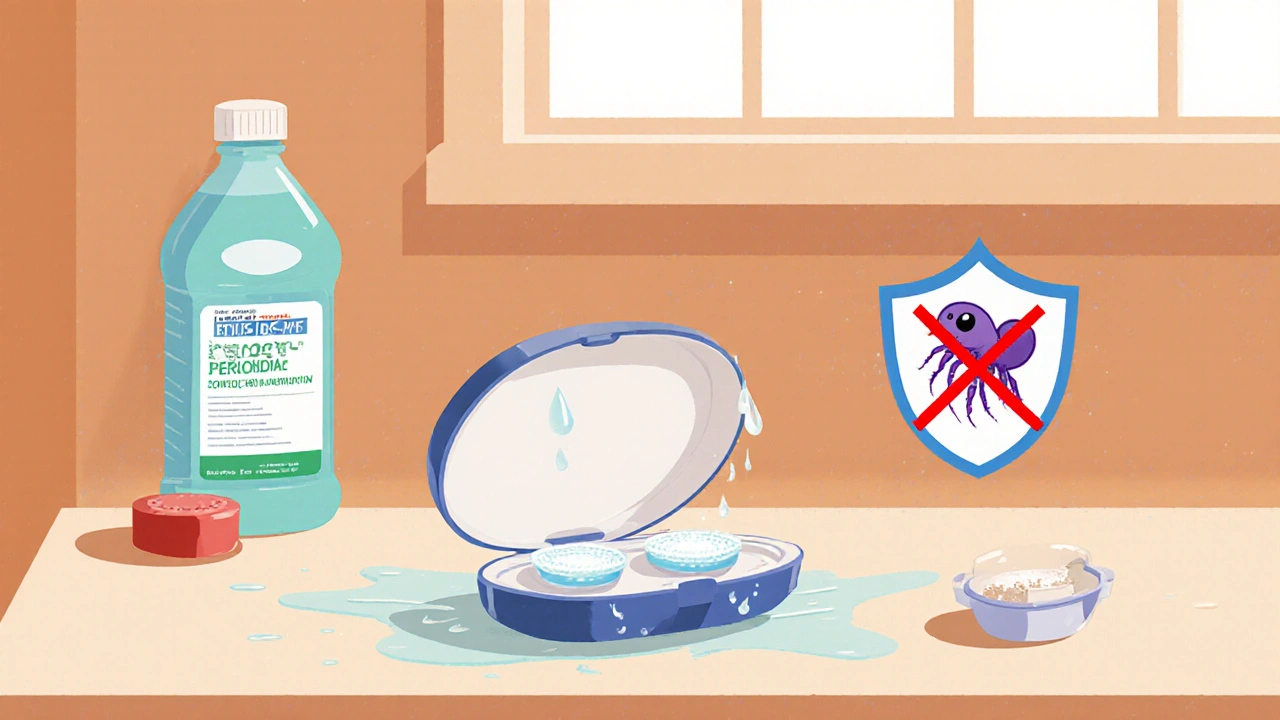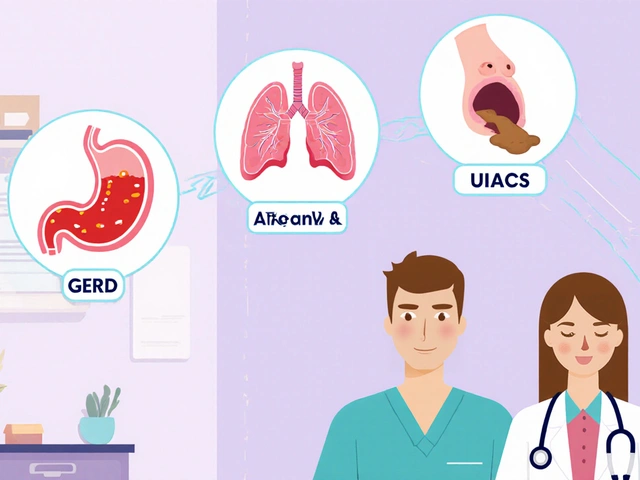Why Contact Lens Safety Isn’t Just a Recommendation
Every year, about 1 in every 1,000 contact lens wearers ends up with a serious eye infection. That might sound rare, but when you consider that over 80 million people in the U.S. alone wear contacts, that’s tens of thousands of preventable cases. And the worst part? Most of these infections happen because someone skipped a simple step-like washing their hands or replacing their lens case.
You don’t need to be a doctor to know that your eyes are delicate. But you do need to know how to protect them. Contact lenses are medical devices. They sit directly on your cornea, and anything that gets between the lens and your eye-bacteria, dirt, water, even leftover solution-can cause damage. The good news? Almost all serious problems can be avoided with basic, consistent habits.
Hand Hygiene: The First and Most Important Step
Before you touch your lenses, wash your hands. Not just a quick rinse. Not a splash of sanitizer. Wash them with plain soap and water for at least 20 seconds, scrubbing between your fingers, under your nails, and around your thumbs. Then dry them with a lint-free towel. No paper towels. No towels with loose threads. Those tiny fibers can stick to your lenses and scratch your eye.
Why does this matter so much? Your hands touch doorknobs, phones, pets, money, and who knows what else. Studies show only about half of contact lens wearers wash their hands properly before handling lenses. That’s why the National Institutes of Health calls handwashing the "most important and fundamental principle of infection control." Skipping this step is like putting a dirty sock on your eye.
And don’t use alcohol wipes or hand sanitizer. They might kill germs, but they leave behind chemicals that can burn your eyes or damage the lens material. Stick to soap and water. It’s cheap, effective, and proven.
Choosing and Using the Right Solution
Not all contact lens solutions are the same. Your eye care professional recommended a specific brand for a reason. Some solutions work with silicone hydrogel lenses. Others are made for daily disposables. Some are hydrogen peroxide-based. Using the wrong one can cause irritation, clouding, or even chemical burns.
Here’s what you should never do:
- Never use tap water to rinse or store your lenses.
- Never use saliva to wet your lenses.
- Never top off old solution with fresh solution.
- Never use saline solution or rewetting drops as a disinfectant.
Tap water is the biggest hidden danger. It may look clean, but it can carry Acanthamoeba, a microscopic parasite that burrows into the cornea and causes a rare but devastating infection. Treatment can cost over $7,500-and sometimes doesn’t even save your vision. The FDA warns that swimming or showering with contacts increases your risk of infection by 10 to 15 times.
If you use hydrogen peroxide systems (like Clear Care), follow the instructions exactly. These systems need 6 hours to fully neutralize the solution. If you put the lenses in your eyes too soon, you’ll feel a burning sensation that could last for hours. And never rinse lenses with hydrogen peroxide directly-always let the system do its job.

Lens Case Hygiene: The Forgotten Risk
Your lens case is a breeding ground for bacteria if you don’t treat it right. Most people rinse it with water and leave it capped. That’s a recipe for trouble.
Here’s the correct routine:
- After removing your lenses, empty the case.
- Rinse it with fresh disinfecting solution-not water.
- Let it air dry upside down with the cap off. This lets moisture evaporate and stops germs from growing.
- Replace the case every three months, no exceptions.
Some people replace their case every month. That’s even better. A 2023 Reddit user reported zero infections for two years after switching from replacing their case every three months to every month. That’s not luck. That’s science.
And don’t leave your case in the bathroom. Humidity and mold love that environment. Store it somewhere dry, like your bedroom dresser.
Wear Time: Don’t Push Your Limits
Just because your lenses are labeled "extended wear" doesn’t mean you should sleep in them every night. Only 10-15% of contact lenses are FDA-approved for overnight use. And even those carry higher risks.
Here’s what you need to know:
- Remove lenses before swimming, showering, or even washing your face.
- Never sleep in lenses unless your eye doctor specifically prescribed it.
- Stick to the replacement schedule: daily, biweekly, monthly-no extensions.
One user on Reddit shared how they woke up with a red, painful eye after sleeping in daily disposables once. They haven’t done it since. That’s the kind of lesson you only need to learn once.
And don’t think you’re being "productive" by wearing lenses longer than recommended. Your cornea needs oxygen. When you wear lenses too long, especially overnight, you’re starving it. That leads to swelling, redness, and eventually, permanent damage.
Daily Disposables: The Easiest Way to Stay Safe
If you’ve been struggling with cleaning routines, consider switching to daily disposable lenses. They’re the single biggest safety upgrade most wearers can make.
Why? Because you never store them. You never clean them. You never risk contamination from a dirty case or old solution. You open a fresh pair every morning, wear them all day, and toss them at night. No exceptions.
Daily disposables now make up 65% of the U.S. contact lens market-up from 45% just six years ago. That’s not a trend. That’s a public health shift. They cost a bit more per pair, but they eliminate 80% of the risks tied to lens care. For many people, especially teens and young adults, they’re the smartest choice.
Who’s at Highest Risk?
Eighty-five percent of contact lens complications happen in people aged 18 to 24. Why? Because they’re busy, tired, or think they’re invincible. They sleep in lenses. They rinse cases with tap water. They skip handwashing.
It’s not about being careless. It’s about not knowing better. Many young users get their first pair from a vending machine or online without a proper fitting or education. That’s dangerous. Contact lenses aren’t glasses. They’re medical devices that require training.
If you’re under 25, you’re statistically more likely to end up in the ER because of a contact lens mistake. That’s why eye care professionals now spend extra time with younger patients-not just to fit lenses, but to make sure they understand the rules.
What Happens If You Ignore These Rules?
Most people think eye infections mean a little redness and discomfort. That’s true-but it’s also the tip of the iceberg.
Corneal ulcers can form in just 24 hours. These are open sores on your cornea. They cause severe pain, light sensitivity, blurred vision, and sometimes permanent scarring. If left untreated, they can lead to blindness.
Acanthamoeba keratitis is even scarier. It’s rare, but it’s nearly impossible to cure. Antibiotics don’t work. The parasite clings to the cornea like glue. Treatment can take months. Some patients need corneal transplants. And even then, vision doesn’t always come back.
And the cost? Not just medical bills. Think lost workdays, missed school, anxiety, and lifelong vision changes. One study estimated the lifetime cost of permanent vision loss from a contact lens infection can exceed $300,000.
None of this has to happen.
What You Can Do Today
Start with one change. Pick one habit that’s been slipping:
- Wash your hands before touching your lenses.
- Replace your case this week.
- Stop sleeping in your lenses.
- Throw away that bottle of saline and buy the right disinfectant.
Do it now. Don’t wait for a warning sign. Don’t wait until your eye feels sore. Prevention isn’t optional. It’s the only way to keep seeing clearly for decades.
If you’re unsure about your routine, schedule a quick check-up with your eye care provider. Ask them: "Am I doing everything right?" Most will be happy to walk you through it. They’ve seen too many preventable cases.
Can I use water to clean my contact lenses?
No. Never use tap water, bottled water, or distilled water to clean or store your contact lenses. Water can contain harmful microorganisms like Acanthamoeba, which can cause a rare but serious eye infection that may lead to permanent vision loss. Always use the disinfecting solution prescribed by your eye care professional.
How often should I replace my contact lens case?
Replace your lens case at least every three months. Many eye care professionals recommend replacing it every month, especially if you’ve had an eye infection before. Always rinse the case with fresh solution after each use, never water, and let it air dry upside down with the cap off to prevent bacteria growth.
Is it safe to sleep in contact lenses?
Only if your eye doctor specifically prescribed extended-wear lenses-and even then, it’s not risk-free. Most contact lenses are designed for daily wear only. Sleeping in them increases your risk of corneal infections by up to 10 times. If you accidentally fall asleep in your lenses, remove them as soon as possible and don’t reuse them unless your doctor says it’s safe.
Can I reuse daily disposable contact lenses?
No. Daily disposable lenses are designed to be worn once and thrown away. Reusing them-even for a second day-increases your risk of infection, discomfort, and corneal damage. They’re thinner and more fragile than other lenses, and cleaning them doesn’t restore their integrity. Always use a fresh pair each day.
What should I do if my eye becomes red or painful while wearing contacts?
Remove your lenses immediately and do not put them back in. Do not try to treat it with over-the-counter eye drops unless directed by your eye care provider. Call your optometrist or ophthalmologist right away. Redness, pain, light sensitivity, or blurred vision could be signs of a serious infection like a corneal ulcer or Acanthamoeba keratitis. Early treatment is critical to saving your vision.







i've been wearing contacts for 12 years and never had an infection, but i did learn the hard way that tap water is a no-go after a swim trip. i rinsed my case with bottled water once-thought it was fine. woke up with a gritty, burning eye. turned out to be a minor corneal abrasion from debris, but the fear stuck. now i use fresh solution every time, even if the case looks clean. better safe than sorry.
let me tell you something they don’t want you to know-contact lens companies are pushing daily disposables because they make more money, not because they’re safer. the real danger? the FDA’s approval process is rigged. they ignore the fact that silicone hydrogel lenses reduce oxygen flow by 40% compared to older models, but nobody talks about that. they just slap a ‘high oxygen’ label on it and sell you a $300 box. meanwhile, your cornea is slowly suffocating. and don’t even get me started on how they market ‘extended wear’ like it’s a feature, not a trap. i’ve seen people sleep in lenses for weeks. it’s not negligence-it’s corporate manipulation. you’re being sold a slow-motion eye disaster wrapped in a pretty package.
For the record, the NIH’s statement on hand hygiene is not merely a recommendation-it is a non-negotiable cornerstone of ophthalmic infection control, grounded in peer-reviewed microbiological data. The notion that ‘a quick rinse’ suffices is not only scientifically indefensible, it is an affront to public health literacy. Furthermore, the use of lint-free towels is not a suggestion-it is a biomechanical imperative. Paper towels, even those marketed as ‘premium,’ shed microfibers at a rate of 12–18 per cm² under friction. These fibers, when deposited on the ocular surface, induce mechanical keratopathy, which can predispose to bacterial colonization. I have personally documented this phenomenon in clinical case studies. Do not underestimate the biomechanics of lint.
My mom lost vision in one eye from a contact infection in her 20s. She never wore lenses again. I switched to daily disposables last year and haven’t had a single irritation. It’s not about being perfect-it’s about making the easiest, safest choice. Seriously, just buy the dailies. It’s worth it.
It’s worth noting that the prevalence of Acanthamoeba keratitis is inversely correlated with the adoption of hydrogen peroxide-based disinfection regimens. The CDC’s 2021 surveillance data indicates a 62% reduction in cases in regions where peroxide systems exceeded 50% market penetration. However, compliance remains suboptimal due to user error-specifically, premature lens insertion post-neutralization. The 6-hour dwell time is non-negotiable. Any deviation constitutes a failure in biofilm disruption protocols. I recommend pairing peroxide systems with UV case sanitizers for additive efficacy.
Okay, so let me get this straight-you’re telling me that millions of people have been wearing contacts for decades, and suddenly now we’re supposed to believe that rinsing a case with water is going to turn us all into blind, crying zombies? I’ve worn contacts since I was 15. I’ve showered with them, rinsed them with bottled water, reused my case for two years, and I’ve never even had a red eye. Meanwhile, I’ve had three sinus infections from mold in my bathroom. But apparently, the lens case is the real killer? The real danger is fearmongering dressed up as ‘public health advice.’ Who benefits from making people paranoid about every little thing? The lens companies. The solution manufacturers. The eye doctors. And now you’re all just sheep following the script. Wake up. Your eyes are fine. Stop buying into the fear.
Handwashing? Case replacement? You’re treating contact lenses like surgical instruments. They’re not. They’re soft plastic. You’re over-engineering a simple product into a medical ordeal. I’ve worn contacts for 18 years. I’ve never washed my hands before touching them. I use tap water when I’m out. I reuse my case. I sleep in them. And I see just fine. You’re not protecting your eyes-you’re feeding an industry that profits from anxiety. If your eyes are that fragile, maybe you shouldn’t be wearing contacts at all. Or maybe you just need to stop reading fear-based blogs written by people who’ve never worn lenses in their life.
Look, I get it-some of this stuff sounds overwhelming. I used to be the person who forgot to replace my case for a year, slept in lenses because I was tired, and thought saline was ‘close enough.’ Then I had a scary episode-redness, pain, blurred vision for three days. Turned out it was just a minor irritation, but it scared me enough to change. I switched to daily disposables. I started washing my hands. I replaced my case every month. It’s not about being perfect. It’s about being consistent. And honestly? It’s way easier than you think. I didn’t become a hygiene ninja-I just made one small change at a time. If you’re overwhelmed, start with one thing. Just one. Maybe it’s washing your hands. Maybe it’s tossing your old case. Do that, and then give yourself credit. You’re not failing-you’re learning. And that’s what matters.